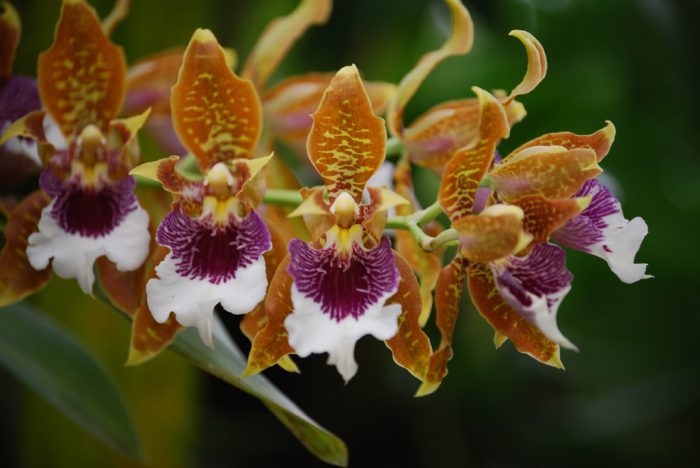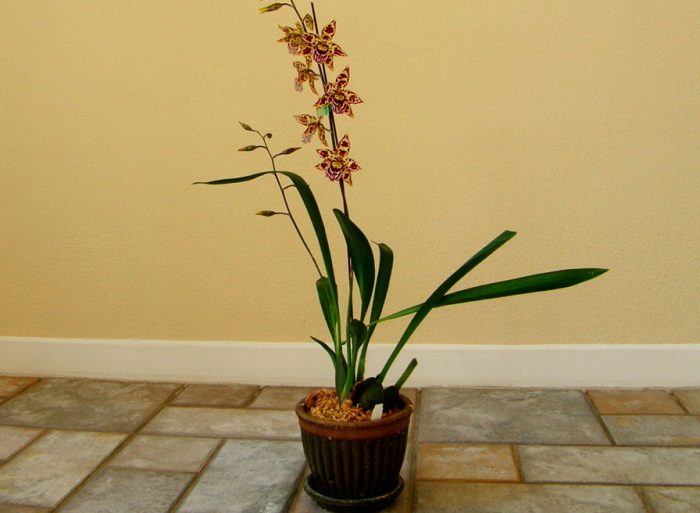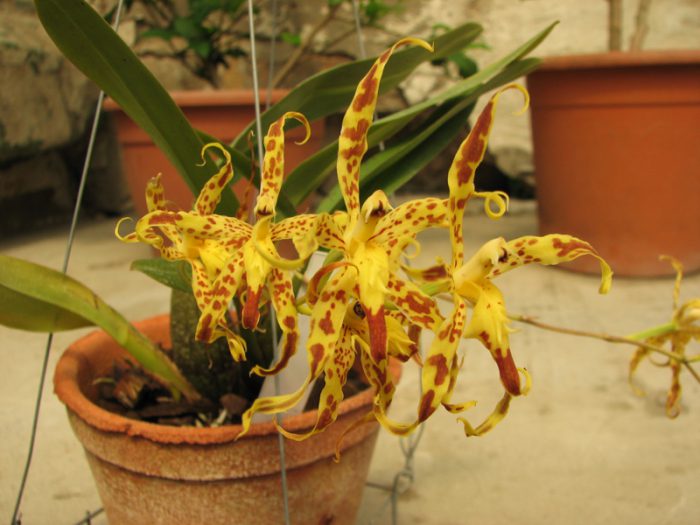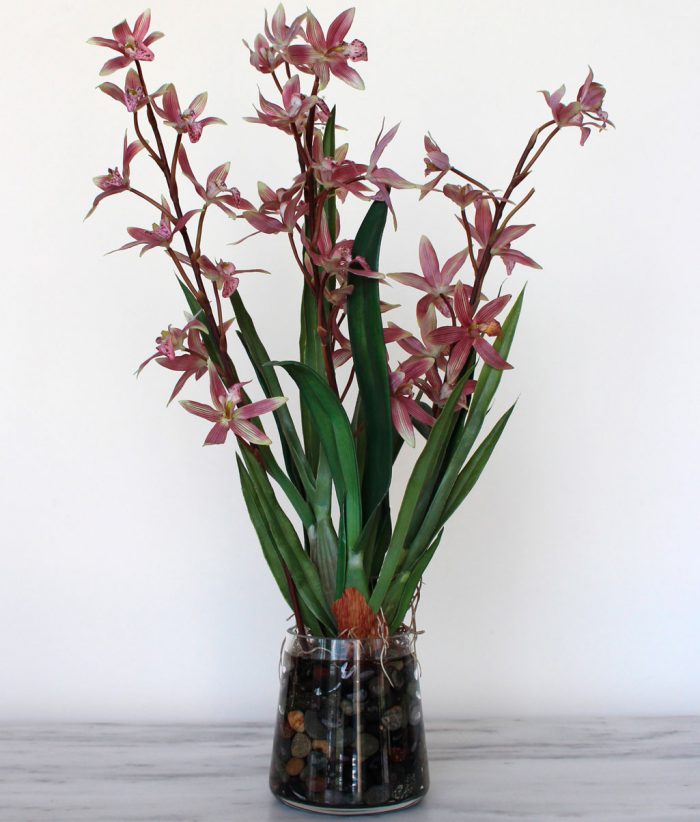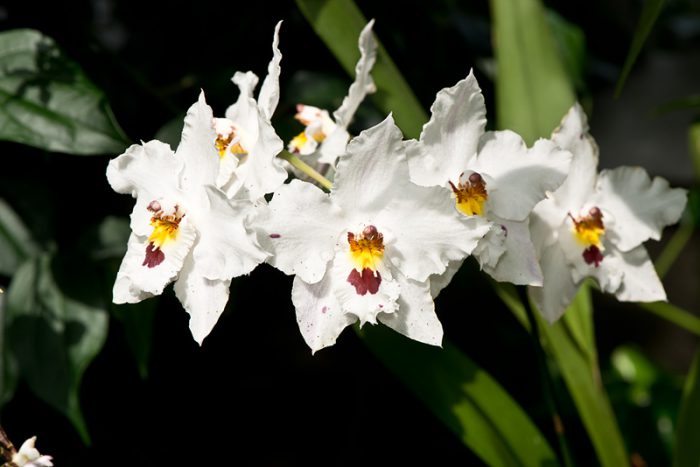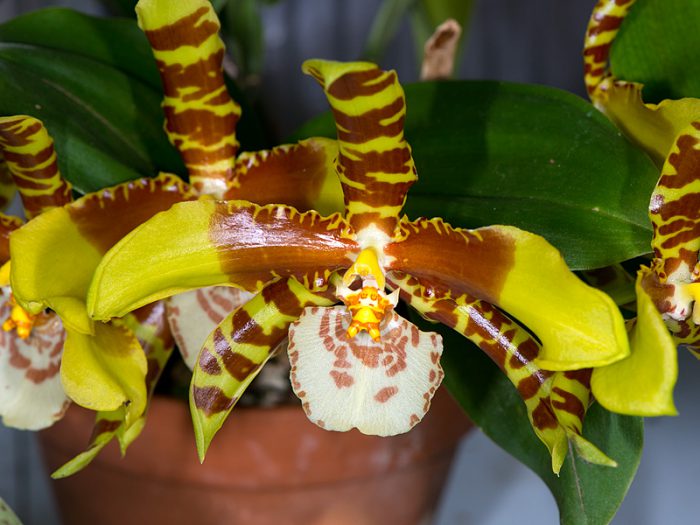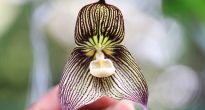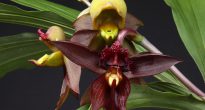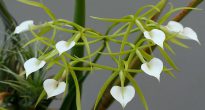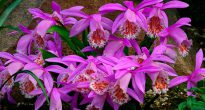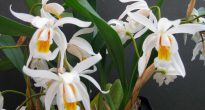Genus odontoglossum (Odontoglossum) is directly related to the rather extensive orchid family (Orhidaceae). This family is also called orchis, and it includes 5 more subfamilies. Representatives of this family have been found in all regions of the planet Earth with the exception of Antarctica. This genus unites 65 species of various plants. In nature, such plants are found in the mountainous regions of South and Central America with tropical and subtropical climates. As a rule, they are found at an absolute altitude of 1700 to 3000 meters. But there are species that prefer to grow in even higher places, where it is cool and damp.
The name of such a plant comes from the Greek words "odons" or "odontos" - "tooth" and "glossa" - "tongue". This unusual name is associated with the appearance of the flowers of this orchid. So, at the base of the lip (lower petal), calloused outgrowths very similar to teeth are clearly distinguishable. This genus was first described by the German botanist Karl Kunt, and this happened in the early 19th century.
This genus is represented by lithophytes (plants that grow on mountain or rock formations), as well as epiphytes (grow on the trunks or branches of other shrubs or trees). Odontoglossum can be large or medium in size. On rare occasions, this flower grows like a land plant. Rather short roots, there is a flattened pseudobulb shape, with rather delicate root processes attached. The average height of odontoglossum is 20 centimeters, but there are varieties that stretch up to 90 centimeters.
The color of the thin leathery leaves is bright emerald, and their shape is highly elongated. With good care, foliage has a lifespan of several years. The growth pattern of the plant is sympodial. A spectacular bush consists of a whole system of shoots. The horizontally located parts of the stems form the rhizome. And on the parts located vertically, pseudobulbs (thickenings) are formed. Peduncles grow from the base of the pseudobulb, and several pieces of lovely flowers are located on them at once. This flower bud is located at the beginning of the growth of the previous leaf or stem (this may be the placement of an underdeveloped leaf sinus).
Odontoglossum is almost impossible to find in flower shops. However, there are a huge number of hybrids created by crossing odontoglossum with other species of the orchid family. At the same time, this kind of orchid crosses very easily. Hybrids are usually very beautiful and have a long flowering period from mid-fall to late spring. It should be remembered that different varieties can bloom at any time of the year.When their flowering ends, a dormant period begins (it is observed every 8 months). Odontoglossum is most suitable for growing experienced orchid growers, as beginners can have a number of problems with such a plant.
Content
- 1 Caring for the odontoglossum orchid at home
- 2 Video review
- 3 Main types
- 3.1 Odontoglossum bictoniense (Odontoglossum bictoniense)
- 3.2 Odontoglossum pretty (Odontoglossum pulchellum)
- 3.3 Odontoglossum crispum (Odontoglossum crispum)
- 3.4 Odontoglossum lemon (Odontoglossum citrosmum)
- 3.5 Odontoglossum cordatum (Odontoglossum cordatum)
- 3.6 Odontoglossum large (Odontoglossum grande)
Caring for the odontoglossum orchid at home
Illumination
This orchid is quite light-requiring and needs good lighting. However, it should be protected from direct sunlight. Southwestern or southeastern windows are perfect for placing such a flower. When placed on a southern window, the flower will need shading from the scorching midday rays of the sun. You can shade the plant using light curtains or gauze curtains. If desired, paper or tracing paper can be glued to the surface of the glass, which can significantly scatter sunlight.
Temperature regime
Orchids of this kind are adapted to a cool temperature regime; therefore, they are recommended to be grown in unheated greenhouses or cold rooms. But hybrids created by crossing with thermophilic species are quite adapted to normal room temperature. In summer, such plants are recommended to be kept at a temperature of 24 to 26 degrees, but it is best if it is 19 degrees in the daytime, and 16 degrees at night. The recommended temperature in winter is from 13 to 17 degrees.
Humidity
Odontoglossum requires high air humidity for normal growth and development. So, during the day it should stay at 60 percent, and at night it should rise to 90 percent. If the humidity is below normal, then this will lead to a deterioration in the appearance of the flower, as well as its development. It is worth remembering that the warmer it is in the room, the higher the percentage of humidity should be and the more often ventilation is carried out. In the summer, during the hot months, it is recommended to place the pot with the plant in a wide and high tray, into which you should first add expanded clay (pebbles) and pour in a small amount of water. When the water evaporates, the air humidity will naturally rise. However, care should be taken that the liquid does not come into contact with the pot, as this can cause rot on the root system.
How to water
Watering frequency is directly related to the ambient temperature of the odontoglossum. So, the cooler it is in the room, the less often you need to water it and vice versa. When choosing a pot, it should be borne in mind that excess liquid should freely and quickly leave it. In this regard, it is recommended to use double pots, so, in the part located on top, the flower itself is placed, and the one on the bottom is intended for flowing excess water. If liquid stagnates in the substrate, this will lead to the appearance of rot on the root system, as well as on the shoot.
Watering should be frequent and plentiful, and should be done without waiting for the substrate to dry completely. At the same time, care must be taken that the pseudobulbs do not wrinkle between waterings. After the end of flowering, the frequency of watering should be reduced. And during the rest period, watering is carried out with a frequency of 1 time in 7 days.
In the presence of young sprouts, you need to moisten the plant carefully enough, because they are quite sensitive to such procedures.Experts advise, from time to time to arrange a warm (about 35 degrees) shower for this orchid, which has a positive effect on the health and general development of such a flower. The more often you shower him, the more young leaves will appear, and this will also lead to an increase in the flowering frequency. Remember that you should not use too hard water for the shower. Melt or rainwater is excellent for such procedures. In the absence of it, you can combine distilled and tap water in equal proportions. You can also soften tap water by boiling, filtering, and it can also be well defended. It should be remembered that the water for irrigation should have a temperature of 20 to 23 degrees.
Fertilizer
After the end of the dormant period, you need to start applying specialized fertilizers for orchids to the substrate. You can also use a liquid fertilizer with a complex of minerals. It should be noted that the nutrient mixture used for feeding should be very low in concentration. During the period of intensive growth, you need to feed the plant once a week, and during flowering - once every 3 weeks.
After the young sprouts are half their normal size, you need to start feeding the orchid with a fertilizer with a high content of phosphorus compounds. In addition to the usual dressings, foliar should also be carried out. It is necessary to carry out top dressing on the sheet with the same type of fertilizer. Experts recommend using these fertilization methods in turn.
Features of transplantation and soil mixture
In order for the plant to grow normally and to bloom, the transplant should be carried out once a year, and not only the substrate, but also the pot should be changed. It is recommended to transplant it before flowering or after it (in spring or autumn). Often, odontoglossum itself signals that it is time to transplant, so, it has a young shoot, which reaches 5 to 8 centimeters in length. Also, a transplant is necessary with a half-decomposed substrate. When changing the container, experts recommend carefully separating the old pseudobulbs.
It is worth remembering that transplantation is prohibited in extreme heat.
Suitable soil should be light, breathable and absorb water. So, when transplanting, you can use ready-made soil mixtures sold in a flower shop, intended for orchids or for orchids and bromeliads. There are 2 options for the substrate that you can prepare with your own hands:
- peat soil, chopped sphagnum and crushed charcoal, while the components are taken in equal proportions;
- mix in equal proportions pine bark, coconut chips (fiber), chopped fern roots and chopped charcoal.
Don't forget to make a good drainage layer at the bottom of the pot. After transplanting, a not very thick layer of moss should be laid on the surface of the substrate, which will help to retain moisture in the soil. The first watering of the transplanted plant must be done 7 days after this procedure.
Reproduction methods
Odontoglossum can be propagated during its transplant, for this you should divide the overgrown bush into parts. When dividing the rhizome, remember that each division must have at least 2-3 mature pseudobulbs and another 1 (or more) growth point. The rhizome is carefully cut with a very sharp knife.
Damaged places on the cuttings must be treated and crushed activated carbon is excellent for this. Then the delenki should be carefully laid on pre-chopped moss and wait until the roots begin to grow again. Then the newly started growing delenki should be planted in separate flower pots. To do this, the root system of the plant is placed in a pot with a pre-made drainage layer. And only after that the prepared substrate is carefully poured.
Pests and possible problems
Often they settle on this kind of orchids thrips, aphids, spider mites, and scabbards... Experts recommend fighting such harmful insects with the help of special insecticides. If liquid stagnates in the substrate, this can provoke the appearance of various bacterial as well as fungal rot. In this case, experts advise to carefully remove the root system from the substrate and treat it with fungicides. You also need to disinfect the pot itself, and plant the plant in a new substrate.
As a rule, all problems that have arisen during the cultivation of this plant are associated with violations of the rules of care. So, this may be due to the wrong level of lighting, wrong temperature conditions or irrigation problems. So, the most common problems are:
- The flower stops growing, and its foliage becomes yellow and shrivels - this is due to too dry indoor air.
- Whitish spots appear on the surface of the foliage - due to stagnant air, it is necessary to increase the number of airings.
- The foliage turned yellow - this may be due to direct sunlight hitting them.
Video review
Main types
The types listed below are the most popular when grown indoors because they are relatively undemanding to care for.
Odontoglossum bictoniense (Odontoglossum bictoniense)
This species stands out from the rest for its flattened pseudobulbs, which, moreover, curl very tightly. This plant reaches a height of 18 centimeters. Below the bush is covered with 4–6 two-row lower leaves. On top of the pseudobulbs there are 2 or 3 long linear leaves. The erect, loose inflorescence has a brush-like shape, and it contains a large number of not very large (diameter from 4 to 5 centimeters) flowers. In length, such an inflorescence can reach from 30 to 80 centimeters. The greenish-yellow flowers consist of narrow sepals and petals, while on their surface there is a pattern in the form of various spots of brownish-chestnut color. The heart-shaped or kidney-shaped lip has a short and wide marigold. The lip has a white or lilac color, a wavy edge and a pair of yellow fluffy keels at the base. Flowering lasts from mid-autumn to early winter. The opening of flowers occurs gradually, while the flowering of the first inflorescence can last for 8-10 weeks.
Odontoglossum pretty (Odontoglossum pulchellum)
This species has been separated into a separate genus called Odontoglossum Schltr. The flattened pseudobulbs are very close to each other. At the top of each of them there is a pair of long keeled linear leaflets, which create dense and rather large formations. Thin, curved stalks grow from the lower leaf sinuses. They bear loose brush-shaped inflorescences, which consist of 4-6 snow-white fragrant flowers. A lip similar in shape to a guitar is directed upwards and at its base there is a ridge in the form of a callus, which has a rich yellow color, and red specks are also located on its surface. Under the lip there is a pair of lateral practically fused sepals, which are almost invisible because of it. Blooms in January – February.
Odontoglossum crispum (Odontoglossum crispum)
The most beautiful species of this genus. On the peduncle there are many tightly-fitting flowers, the patterns of which are always different. The dangling, brush-shaped inflorescences consist of no more than 15 flowers with a fringed edge. The petals are painted lilac or white, and they have a brownish or cherry-colored pattern on them. There are many brownish-yellow spots on the cut lip.
Odontoglossum lemon (Odontoglossum citrosmum)
Inflorescences consist of lilac or light pink flowers, of which there are from 9 to 20 pieces.The lip is pale pink.
Odontoglossum cordatum (Odontoglossum cordatum)
There are 3 to 8 large flowers. The lip has the shape of a heart.
Odontoglossum large (Odontoglossum grande)
Or the "tiger orchid" is one of the most beautiful plants in the orchid family. Mostly found in the mountainous forest areas of central America, or rather, on the high plateaus of Guatemala and Costa Rica. As a rule, it prefers to grow at an absolute height of 2000–2500 meters. Prefers sufficiently lit places that are well ventilated, for example: meadows, forest edges, the banks of streams and rivers. These places, both in the air and in the soil, have a high moisture content throughout the year. This is facilitated by morning dew, which form fogs at night, as well as the evaporation of liquid from reservoirs. Naturalist and plant collector Ure Skinner first described this species when he found it in a mountain gorge near the capital of Guatemala in the early 19th century.
This flower is rhizome, but the rhizome is reliably hidden under pseudobulbs, which have a flattened shape. As a rule, there are 2 or 3 such pseudobulbs. They are located very close to each other and are located above the rhizome. They have leaflets covering them from below. 1 or 2 peduncles grow from the leaf sinus. Drooping inflorescences are racemose and consist of large flowers (diameter from 12 to 15 centimeters), of which there are from 3 to 7 pieces (less often 9). The color of the flowers is rich yellow and rather thick stripes of pale brown color are located transversely on their surface. The petals with wavy edges in the lower part have a pale brown tint and yellow edging, the upper part is saturated yellow. A small rounded lip has a yellowish-white or whitish color, and on its surface there are many reddish spots and strokes. Flowering can occur from early autumn to mid-winter and lasts 4 weeks. Feels fine when grown indoors, but such an orchid definitely needs a cool temperature regime.

